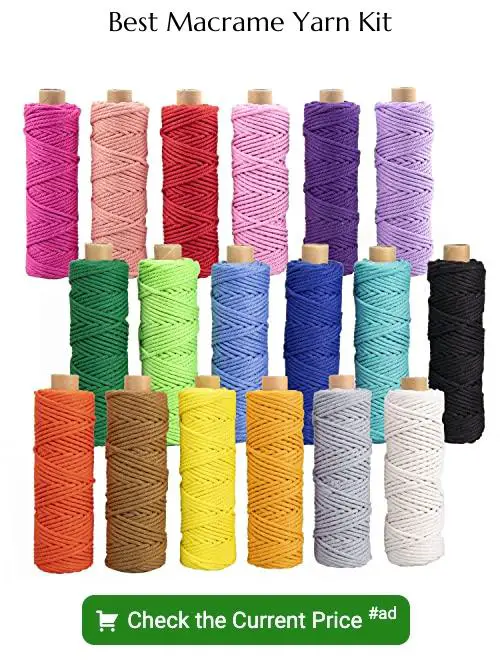Explore the intriguing world of macrame as we delve into techniques for effectively using yarn to craft unique, hand-made decorative pieces.
Macrame, a centuries-old knotting technique, has recently seen a resurgence in popularity and is being used to create everything from wall hangings to plant holders. While traditionally, macrame is done with cotton twine or hemp, yarn can also be a great material to use, especially if you’re looking for a softer look or a wider range of colors.
In this article, you’ll learn exactly how to use yarn for macrame, from choosing the right type of yarn, preparing it for use, and mastering the basic knots. Whether you’re a seasoned macrame artist looking to experiment with new materials or a beginner eager to dive into this craft, this comprehensive guide has got you covered.
Key takeaways:
- Yarn offers more flexibility, thickness, and color options for macrame.
- Cotton, acrylic, and knitting wool are suitable yarns for macrame.
- Consider texture, thickness, color, durability, and ease of care when choosing yarn.
- Cotton yarn provides durability and flexibility for macrame projects.
- Acrylic yarn is versatile, durable, easy to work with, and comes in a wide range of colors.
Understanding the Difference Between Macrame Rope & Yarn

While both macrame rope and yarn are used in creating intricate patterns and designs, they have different qualities and applications. Macrame rope typically refers to a form of cord or twine, often made from cotton, hemp, or synthetic materials. It is generally sturdier, making it ideal for projects that require more structural integrity, like wall hangings, furniture, or outdoor projects.
On the other hand, yarn, usually used in knitting or crocheting, is typically softer and comes in a wider variety of colors and textures. Yarn can have the following properties:
- Higher flexibility. Being softer, yarn allows for more delicate and intricate knotting work. This quality enhances the aesthetic versatility of macrame projects.
- Variety in thickness. Yarn can be thicker or thinner, which helps in crafting different levels of detail in a macrame project.
- Broad color spectrum. Yarn comes in a much wider array of colors than standard macrame cord, offering many creative possibilities.
Even though yarn may lack some of the sturdiness of traditional macrame rope, it can still be used in a variety of macrame projects, from wall hangings to jewelry, lending them a unique and sometimes softer look.
Yarn’s diverse properties make it a versatile choice for macrame, but be sure to base your selection on the specific requirements and desired character of the project at hand.
Types of Yarn Suitable for Macrame

There exists a variety of yarn types suitable for macrame including cotton, acrylic, knitting wool, and more. Each offers unique characteristics and textures that contribute to the final look of macrame projects:
- Cotton yarn is a popular choice due to its strength and durability. Its soft and absorbent nature makes it an excellent candidate for plant hangers and wall hangings. It’s also available in different sizes and lengths to suit various projects.
- Acrylic yarn is lightweight with a slight stretch, making it a user-friendly choice for beginners. This type’s synthetic nature makes it resistant to moth damage, and it’s often more cost-effective than other types.
- Knitting wool, while traditionally used for knitting or crocheting, can bring a soft and cozy touch to macrame projects. This type can look especially engaging in macrame wall hangings, providing a distinctive texture contrast. However, keep in mind wool’s elasticity might make it slightly challenging to work with.
Choosing the right type of yarn depends on the design and texture you’re aiming to achieve in your macrame. Experimentation with different types can lead to unique and stunning macrame creations.
Choosing the Right Yarn for Macrame Projects
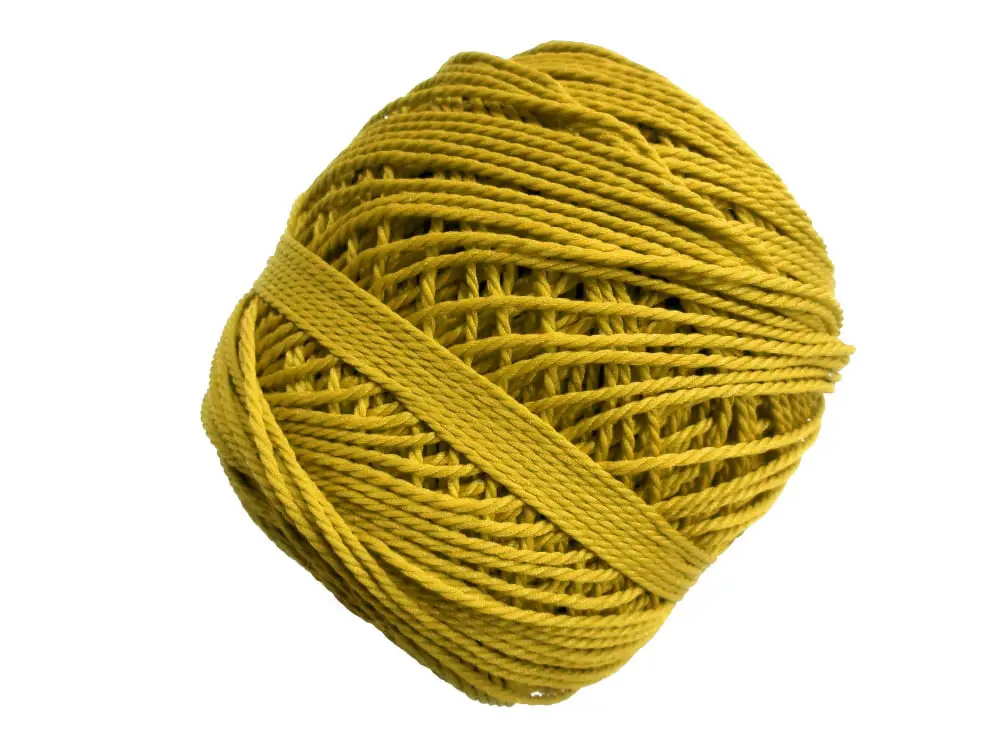
Selecting an appropriate yarn for your macrame project depends on several criteria.
Firstly, consider the texture. This affects the overall appearance and feel of the piece. Cotton yarn for instance, gives a soft, classic look and is easy to knot, thereby making it a popular choice.
The project type dictates the yarn thickness. Thicker yarns create striking, large-scale pieces ideal for wall hangings, while finer yarns suit delicate projects such as jewelry or coasters.
The color is crucial as this contributes significantly to the aesthetics of the final product. Macrame projects often favor natural and neutral tones, but bright, bold colors can draw attention and create a modern look.
Consider the yarn’s durability too, especially for functional items like bags or plant hangers that need to withstand weight and frequent usage. Synthetic yarns like acrylic or nylon offer higher strength and durability compared to natural fibers.
Lastly, remember that ease of care matters. Washability and resistance to fading are essential points to consider, particularly if you plan to sell your macrame creations. Yarns like cotton and acrylic tend to retain their shape and color well after washing.
Insight Into Using Cotton Yarn for Macrame
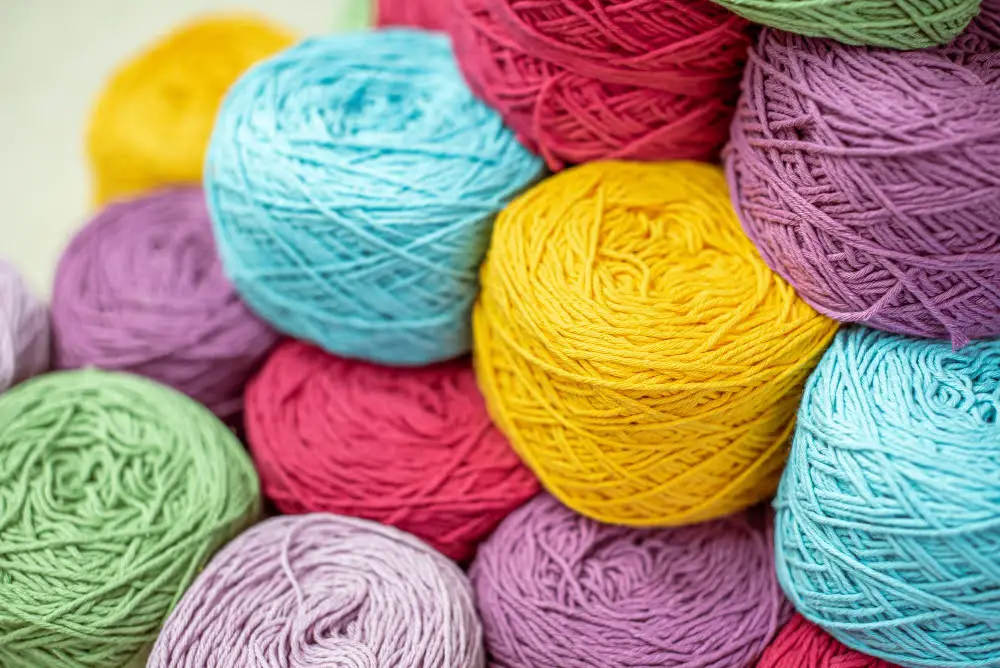
Cotton yarn stands as a favored choice for macrame creations due to its unique features. Notably, the material allows for both durability and flexibility, offering the perfect blend for creatives seeking a resilient yet easily manipulable medium.
Cotton yarn has a robust characteristic that enhances product longevity, making it ideal for projects such as wall hangings and plant hangers expected to bear weight. Contrastingly, its inherent flexibility allows for intricate detailing and design work, enabling a broad scope for stylistic expressions.
When choosing cotton yarn, consider the texture as smooth cotton yarns lend a sleek and polished appearance to the final product, while rough-textured cotton yarns create a rugged and rustic element.
If you’re new to macraming with cotton yarn, start with a simple project. This might include a straightforward wall hanging or plant hanger. Always ensure that the yarn is untangled before beginning to ensure a smoother crafting process.
Bear in mind to maintain tension while knotting. This may require occasional adjustments as knots can tighten or loosen during the crafting process. Striking a consistency in tension leads to a neat and well-structured macrame piece.
Additionally, remember to trim your ends after finishing the project. This can provide your macrame a clean, tidy look. But, before doing so, unravel the ends of the cotton yarn to add a soft, fringed appearance.
Lastly, don’t shy from experimenting with different colored cotton yarns. Adding hues can help bring out unique designs or patterns that can accentuate the overall look of your project.
Features of Acrylic Yarn in Macrame Artwork
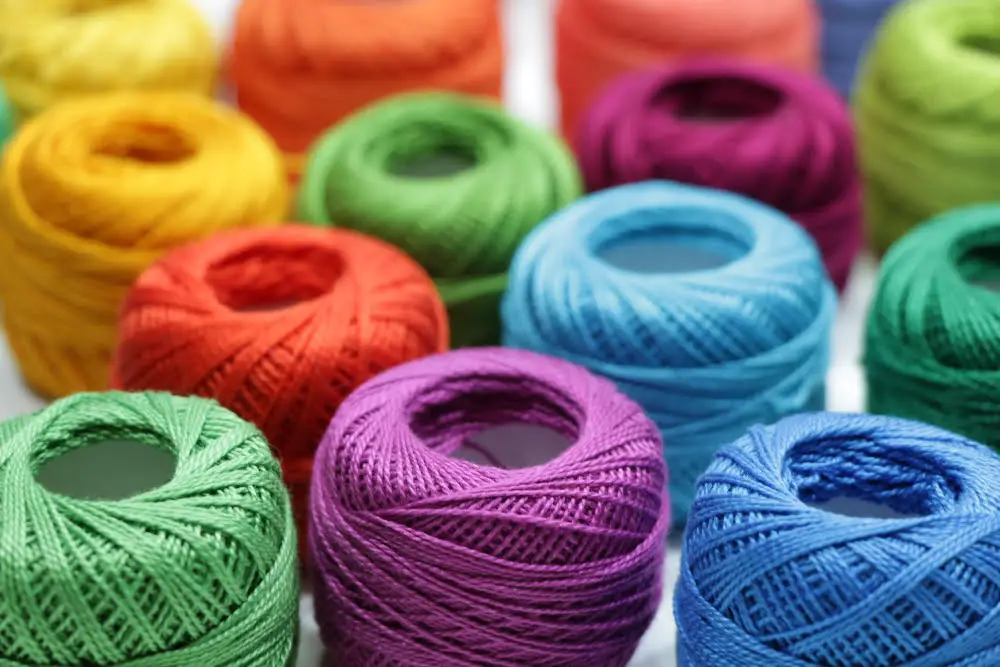
Acrylic yarn stands out due to its versatility and durability, making it a popular pick for many macrame artisans. Some of the key features of acrylic yarn include:
Its synthetic nature allows for a wide range of colors. Yarns can be dyed in any hue imaginable, providing unlimited options for creativity.
It is highly resilient and is resistant to wear and tear. This means that macrame art pieces created with acrylic yarn can maintain their form and color longer.
It’s an exceedingly easy material to work with, particularly for beginners. The consistency of the yarn allows for seamless knotting and unwinding, if necessary.
Being lightweight, it can be used effectively for intricate macrame designs as it doesn’t weigh down the finished piece.
Lastly, it exhibits great washability, so maintaining macrame artworks made from acrylic yarn is generally hassle-free.
To effectively use acrylic yarn in macrame artwork, it’s critical to understand the project first. Before beginning, ensure the chosen yarn color matches the overall theme of the artwork. Additionally, while knotting, maintain consistent tension to create a neat and professional-looking result. Lastly, always take extra care of knots and ends to ensure longevity and neatness of the artwork.
Identifying the Best Macrame Yarn
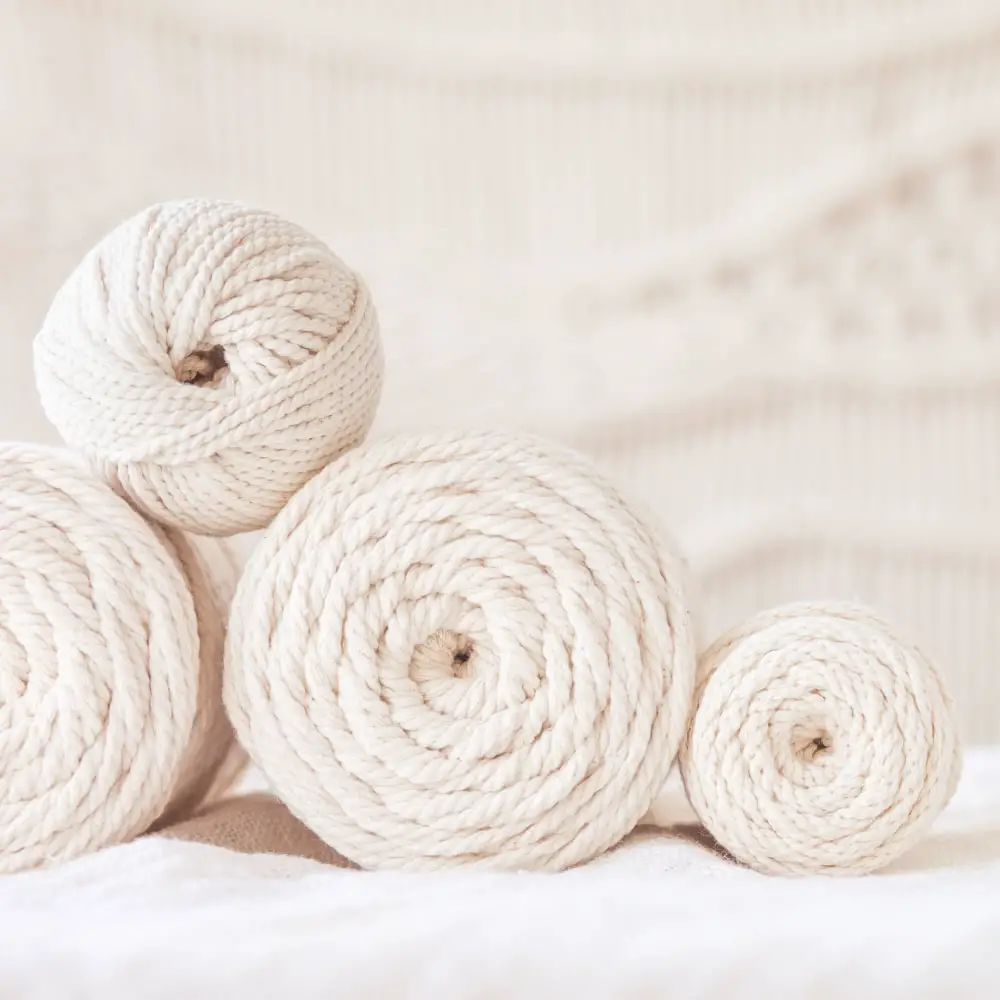
Identifying the ideal yarn for your macrame project can greatly impact the overall aesthetic and strength of your finished piece. There are a few key factors one should consider:
Fiber Content: Natural fibers such as cotton, hemp, or jute are ideal for macrame due to their durability and softness. Synthetic fibers like nylon or acrylic also offer a vibrant color range and are great for outdoor projects.
Yardage: Depending on the size of your project, the yardage or length of the yarn will be a determining factor. Make sure to calculate how much yarn your project needs before making a purchase.
Weight: The thickness of the yarn depends on its weight. Heavyweight yarn makes bulkier knots and can create a chunky macrame look while lightweight yarn is better suited for smaller, intricate designs.
Texture: Smooth yarn is easier to work with and results in even, neat knots while textured yarn can add interesting details but might be harder to knot consistently.
Color: Consider the final look of your macrame project. Natural colors create a boho, rustic look while bright or pastel-colored yarn can yield a modern, fun aesthetic.
By keeping these factors in mind, you can better identify the best yarn for your macrame project. It’s worth spending some time experimenting with different yarn types to understand the impact each can have on your final design.
Experimenting With Knitting Wool in Macrame Projects

Knitting wool can provide unique texture and warmth to your macrame projects. Here’s how you can play around with it:
First, select the right type of knitting wool for your project. Bulky yarns work well for larger projects like wall hangings, while lighter yarns are perfect for smaller items like jewelry or keychains.
While crafting, keep in mind that wool is slightly more forgiving than cotton or other fibers. This means it can make the knots easier to adjust and untie if necessary.
Remember to care for wool correctly, as it’s typically not machine-washable. If your macrame piece gets dirty, opt for spot cleaning or dabbing with a damp cloth instead.
Always practice with a small project first. This way, you can get used to the feel of the knitting wool, its knotting capabilities, and its overall vibe in macrame before committing to a larger project.
Persist even if your first attempt doesn’t turn out as expected. The beauty of macrame lies in its imperfections and unique character each knot lends to the project.
Lastly, don’t forget to enjoy the process of exploring a new kind of material for your macrame projects.
How to Use Yarn for a Macrame Plant Hanger
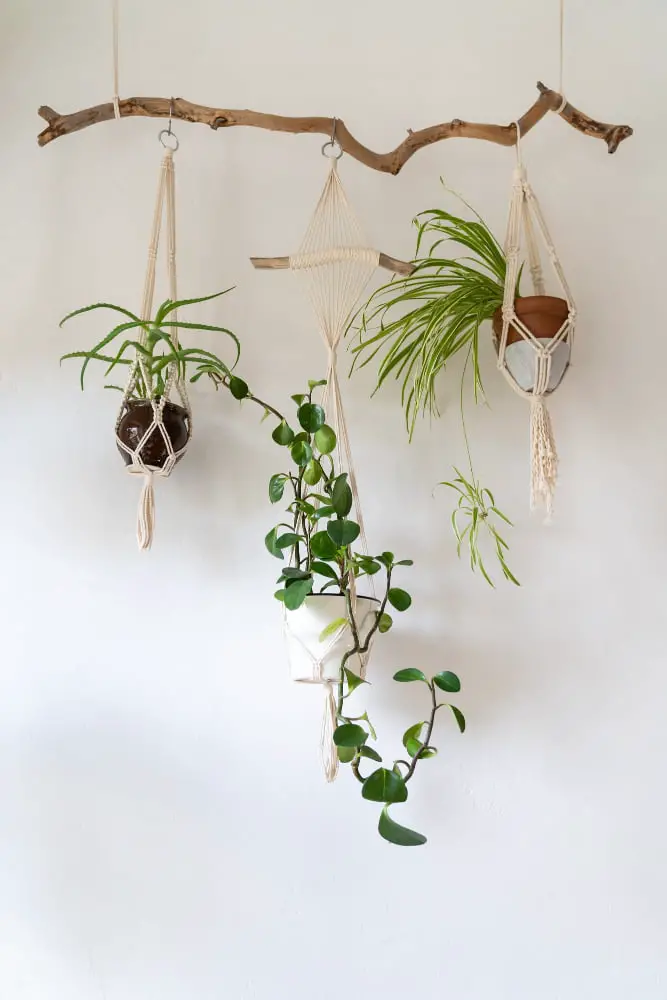
Begin by choosing a soft yet sturdy yarn, such as cotton or wool, ensuring it’s thick enough to hold the weight of the plant. First, cut eight lengths of yarn, with each piece being around six times the desired final length of the hanger.
Next, fold the cut pieces in half to form a loop at one end. This loop serves as a hanger from which the pot will eventually hang. Tie a knot approximately five inches from the loop end, creating the top gathering of your macrame plant hanger.
Identify four groups of two strings each. Starting about two inches under the big knot, tie square knots with each set. Leave some space, approximately three inches, and make another set of square knots but this time, mix the yarn from the adjacent set. This forms a net-like pattern that will hold the plant pot.
Then, leave another three inches of space and tie a final set of square knots using all the strings. This creates the bottom of the hanger. Lastly, cut off the excess yarn to your preferred length, and your macrame plant hanger is ready to hold your favorite plant.
Remember to test the strength of your macrame hanger with a similar weight before placing your chosen plant.
Determining Yarn Quantity for a Macrame Plant Hanger
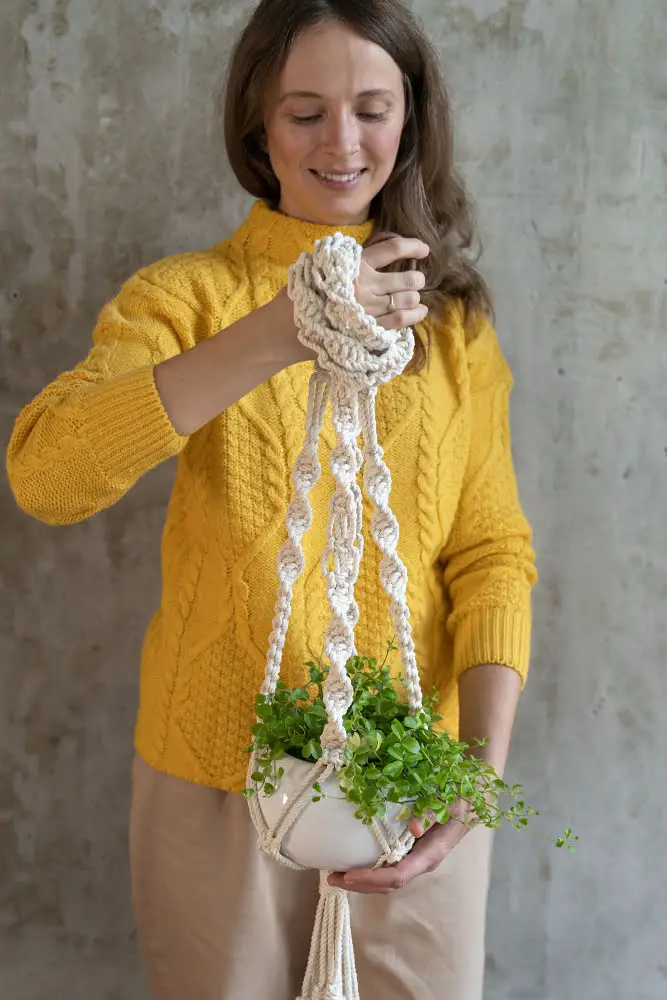
Estimating yarn quantity for a macrame plant hanger hinges on a few key factors.
The project size has a direct influence on the amount of yarn required. A petite hanger intended to cradle a small pot may only need a few yards of yarn, whereas a large, intricate hanger can consume dozens of yards.
The complexity of the design is another element to consider. Simple, straight-forward knots and patterns will use less yarn than more elaborate, decorative knots.
Thirdly, consider the thickness of your chosen yarn. Thicker yarns create more bulk and fill up the project space faster, whereas thinner yarns will take more length to achieve the same volume.
Lastl*y*, always allow extra yarn for adjustments and modifications. If you’re new to macrame or trying a new pattern, an additional 10-15% of your calculated yarn length offers wiggle room for learning and experimentation.
To determine the exact yarn quantity before starting the project, a good practice is to do a small swatch with the yarn and the knots you plan to use, measure the yarn length and the resulting swatch size, and calculate based on the size of your planned work.
Remember, it’s always better to overestimate your yarn requirement a little than to run out midway through the project and have to join a new piece of yarn.
Best Practices for Making Macrame With Cotton
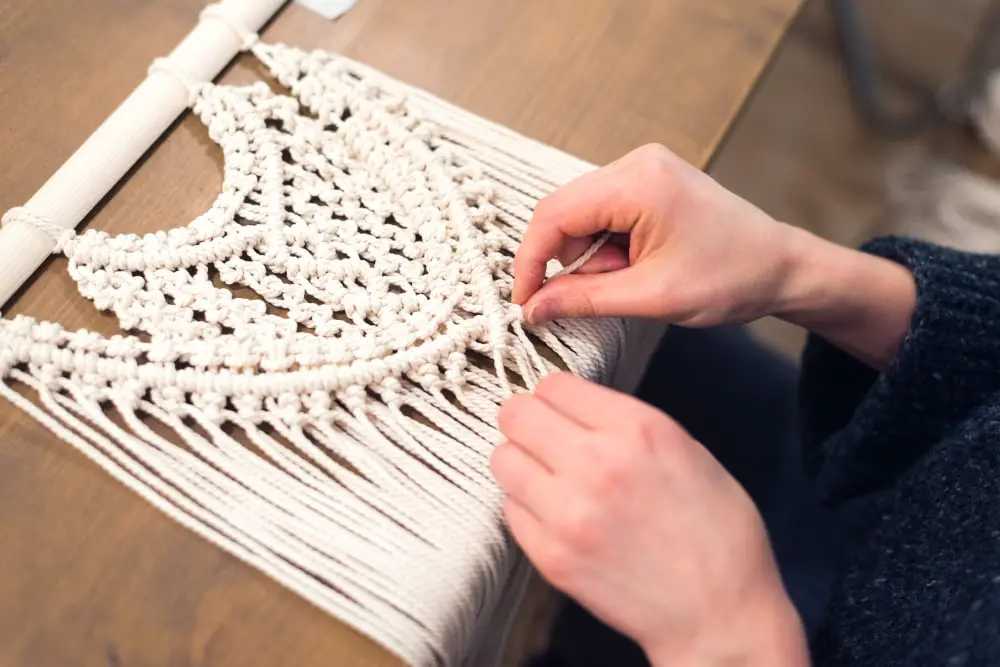
When making macrame with cotton, it’s crucial to consider several best practices. One of the first things to note is cotton’s absorbency, which can drive decisions about the project’s suitability for particular environments, like outdoors.
To prepare the cotton yarn, start by gently twisting it to prevent tangling and knotting. Ensure the cotton strand lengths are proportionate to the desired final project size. Always remember that the length of yarn used in knotting significantly exceeds the finished project length.
Maintain consistent tension when making knots. Uneven tension can impact the symmetry and overall look of the finished product. Cotton’s slight elasticity can make this a challenge, but with careful attention and technique consistency, it’s manageable.
Avoid washing the project with warm water; cotton shrinks under heat. Instead, opt for spot cleaning or cold-water washes when necessary.
Lastly, store your cotton macrame projects in a cool, dry place to prevent the growth of mold or mildew, as cotton is more susceptible compared to synthetic yarns. This practice ensures the longevity of your handmade art pieces.
Keep these instructions in mind when crafting with cotton; however, don’t be afraid to experiment and make personalized adjustments along the crafting journey.
Tips for Handling Yarn While Macraming

Maintain constant tension on your yarn to create even and balanced knots. This can be achieved by firmly yet gently pulling on your yarn after each knot.
Keep all your yarns clean and untangled. A yarn bowl or yarn holder can help keep the yarn secure and untangled as you work.
Strive to use the same type and brand of yarn throughout a single project to maintain consistency in texture and colour.
When working on larger macrame pieces, working in sections can make handling the yarn more manageable.
If mistakes are made, carefully undo the knots instead of cutting the yarn. This can save the material and preserve the overall look of your macrame.
When handling several strands of yarn at once, a macrame board or simply a clipboard could keep the strands organized and in place as you knot.
It’s helpful to cut your yarn longer than you think you’ll need to account for the length taken up by knots.
Pre-stretch your yarn before starting on your knots if you are using a type of yarn that is known to stretch significantly. This ensures the final piece retains its shape and size.
Finally, keep a tight grip on the end of the yarn while finishing a knot to ensure that it doesn’t slip out of your fingers and unravel.
FAQ
Can I use regular yarn for macrame?
While regular yarn can be used for macrame, it is not the ideal choice due to its thin and stretchy nature which can result in smaller than expected knots.
Can you use yarn for macrame projects?
Yes, yarn can be used for macrame projects, considering factors such as its thickness, strength, size, and the tightness when it is knotted.
Can I macrame with crochet yarn?
Yes, you can use crochet yarn for macrame, particularly for small-scale projects.
What types of yarn are most suitable for a macrame project?
For a macrame project, medium weight cotton, hemp, jute, or nylon yarn are most suitable due to their durability and flexibility.
How does the choice of yarn affect the quality of macrame?
The choice of yarn significantly influences the durability, texture, and visual appearance of the finished macrame piece.
Can synthetic yarns be used for macrame, or should one stick to natural fibers?
Synthetic yarns can indeed be used for macrame, although natural fibers like cotton or hemp are often preferred for their texture and strength.
